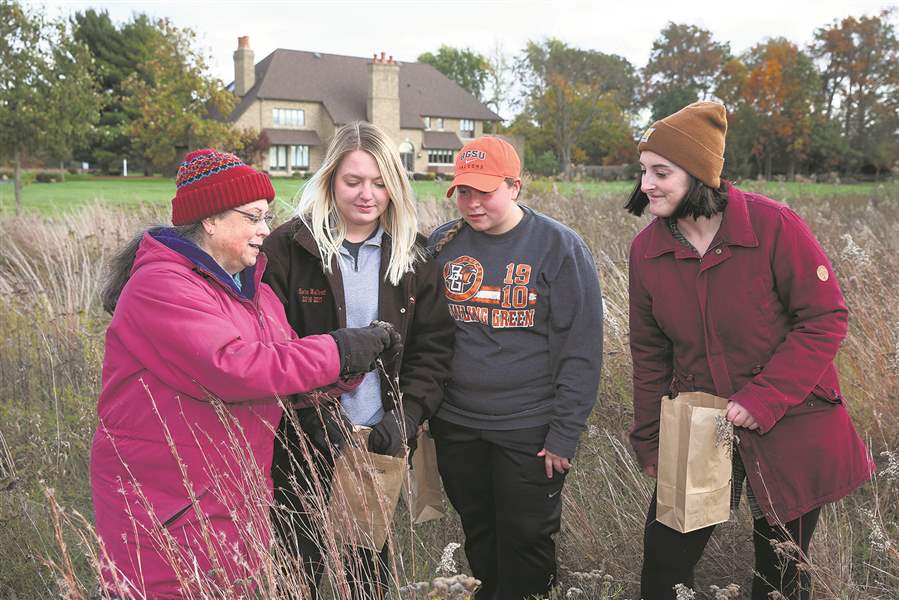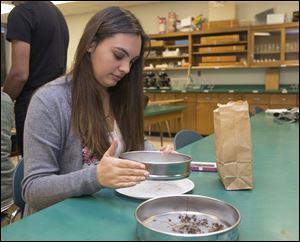
BGSU students gain hands-on experience with invasive plants
12/24/2017
Helen Michaels, left, an associate professor in biological sciences at Bowling Green State University, teaches a restoration ecology class.
The grounds of University House, the official residence of the Bowling Green State University president, include a large manicured lawn. But behind the green lawn is an equally important but less obviously tended space, a short-grass prairie that the university is carefully returning to its native state.
The acreage also functions as a learning lab for students in Helen Michaels’ restoration ecology class, where they can observe and identify native and non-native plant species, encouraging the native varieties while destroying the non-native and “woody invasive” ones.

Helen Michaels, left, an associate professor in biological sciences at Bowling Green State University, teaches a restoration ecology class.
The hands-on and laboratory experiences and field trips of the course complement the theoretical and conceptual background they learn in class.
Although in fall the prairie is brown and dry, it is still an important time for student service-learning. Recently they were out with Ms. Michaels on a gray and chilly day, collecting seeds of plants such as the fragrant mountain mint, big bluestem grass, pearly everlasting, and wild bergamot, or bee balm, for replanting in the spring, when the prairie will be blooming with color.
Students observed as Ms. Michaels demonstrated the use of the improvised “tongs of death,” as she humorously calls the large barbecue tongs fitted with disposable foam paint brushes saturated with an herbicide to kill the undesirable plants.
“These are great for selectively treating tissues of invasive species we don’t want without damaging other plants,” she said. The technique is part of the herbicide training students learn in class.
Armed with a sharp limb cutter, junior ecology and conservation major Tim Kleman tramped through the grass and brush seeking the woody invasives to saw off.
He has experience in this type of removal from his service as the ecology director at the Boy Scout Camp Frontier in Pioneer, Ohio, and is expanding his skills through the restoration ecology class.
“These hands-on experiences are what give the students the skills they need to actually get a job, and it’s clearly helping,” Mr. Michaels said. “And the students seem to love it.”

Haley Meek screens and sorts mountain mint seeds.
Student Katie Wallroff said the experiences have “given me a chance to explore nature in a new way.”
BGSU President Mary Ellen Mazey said she is thrilled that the prairie at the residence can be used as a laboratory.
“BGSU is committed to preparing students for their careers and for lifelong learning. The meadow provides a valuable learning experience for students, and I am so pleased that Dr. Michaels has incorporated the space in her teaching and research,” she said.
The experiences in the course include observing controlled burns, a specialized land management technique, and instruction on how to become certified to obtain official certification, also known as the “red card.”
Benjamin Bomlitz, a nontraditional student who will graduate in December, has interned with the campus operations grounds department and participated in a burn last year at the university’s Poe Prairie site at Mercer and Poe roads.
The Poe Prairie, a tall-grass prairie, is different from the University House short-grass ecosystem and demands different treatment, as do wetlands and forest habitats.
Land management skills include deciding which technique to use, when and if to plant, and soil analysis. Students learn about not only the individual plants but how they function in a plant community.
A student from the 2015 Restoration Ecology class, Dylan Jacobs, volunteered with the Nature Conservancy for his service-learning hours and went on to complete his certification in controlled burns. He was hired as a seasonal employee and is now a permanent Nature Conservancy employee.
“The staff at the Nature Conservancy has allocated and invested considerable time in sharing their expertise and equipment to provide our restoration ecology class with hands-on, active learning experiences,” said Ms. Michaels, an associate professor of biology.
This year, each student must perform 10 hours of service, mostly independently organized by them.
In addition to the university House restoration and extensive work with the Nature Conservancy in Oak Openings and other of its sites, students also do invasive species removal plus forest vegetation analysis for wetland delineation at the University’s Steidtmann Woods.
Other activities include campus prairie restorations, seed collecting and herbiciding at Poe Prairie.
They also perform similar work for the Wood County Park District, Toledo Metroparks and Ohio Natural Areas and Preserves Association.
“The service-learning also allows them to interact with agency people and helps them define their career path,” Ms. Michaels said.
For more information, go to bgsu.edu.